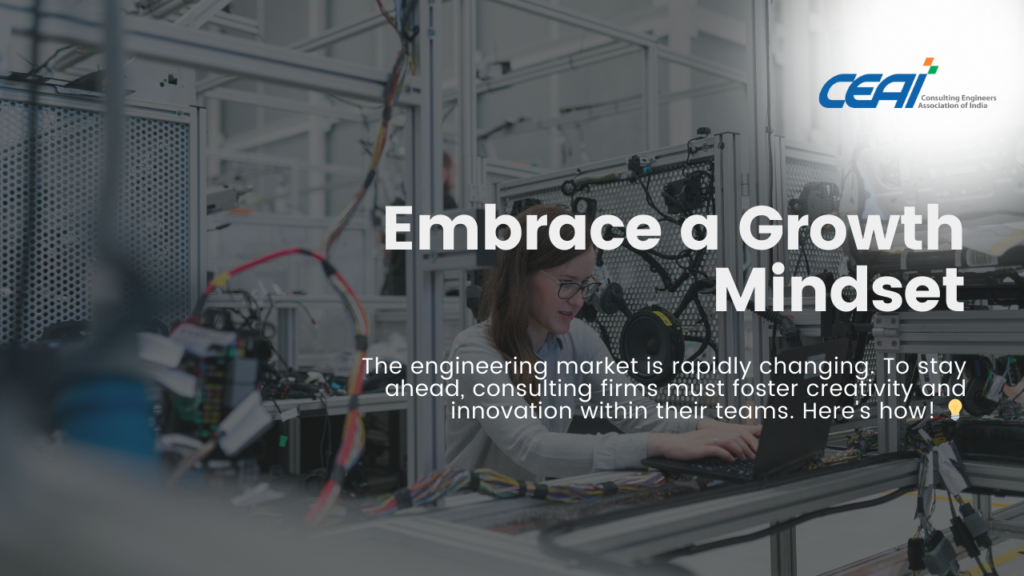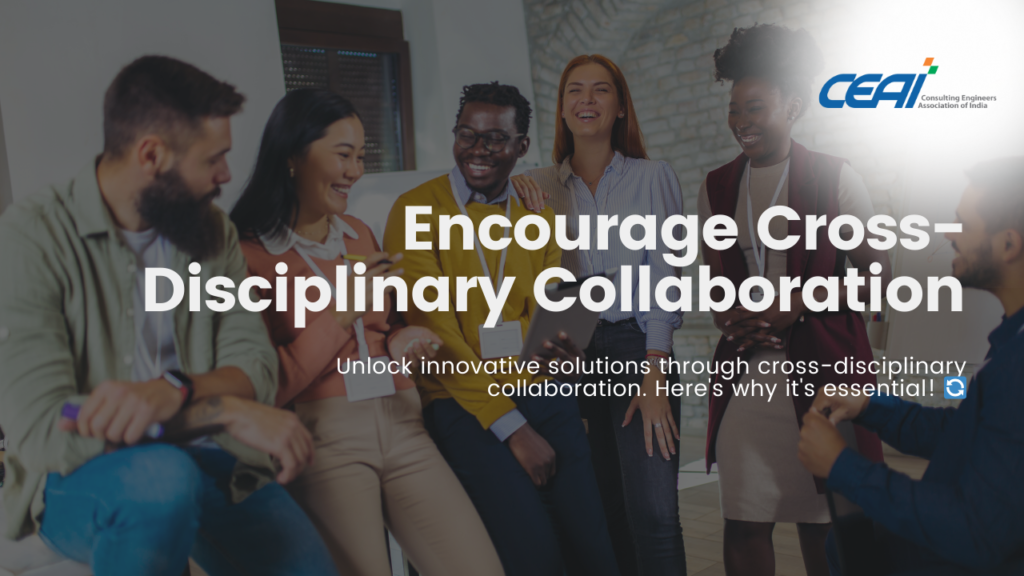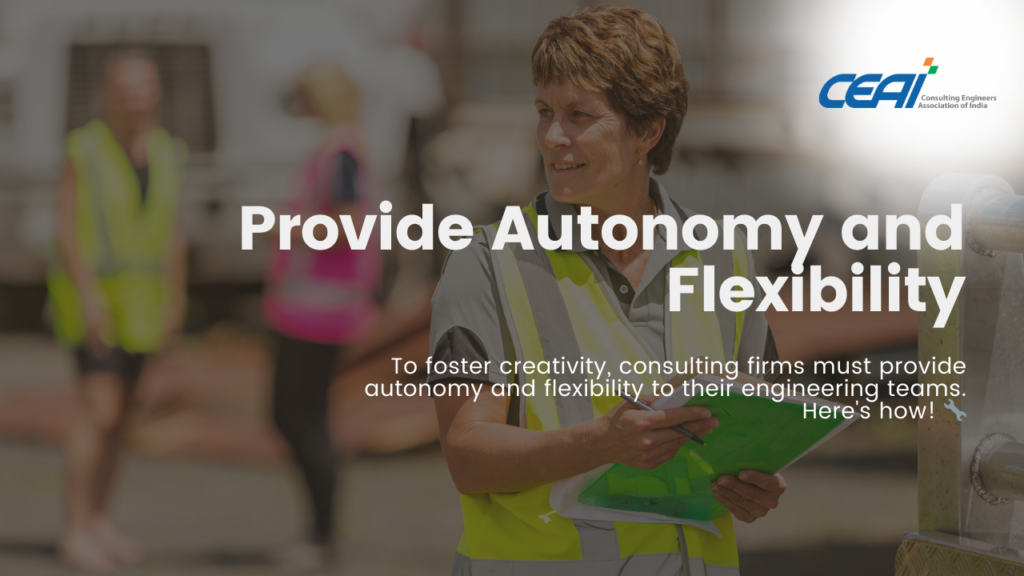The engineering market is changing very dynamically at present, and thus, consulting firms are strictly expected to come out with creative solutions to the problems. Thus, to be one step ahead, it is not only possible but imperative to create a creative work culture. Promoting creativity and innovation within the engineering teams means more drastic ideas, solving problems in a better and more efficient way, and, as a result, creating better conditions for clients.
Nevertheless, how does one create a culture of innovation, an environment where people are encouraged to think freely, particularly when consulting firms, typically deliver work at incredible speed owing to the specifics of the tasks they undertake and high-stakes projects they are involved in? Here are some strategies to consider:
1. Embrace a Growth Mindset

Having a creativity-promoting culture relies on the concept of a growth theory, which underscores that skills and abilities can be attained through practice. Make it possible for your team to change their perspective on every struggle from being a way of perceiving it as a hindrance but rather as a way of perceiving it as a way towards growth. The Libertarian perspective allows employees to be more creative, take more risks, and try new things to improve organizational performance consistently because the corporate deterministic outcomes that focus on getting higher scores at a fast pace are no longer expected.
2. Encourage Cross-Disciplinary Collaboration

This is a general statement that can be applied to almost any field of innovation, to emphasize that it is usually found at the crossroads of two or more fields of knowledge. Encourage interprofessional cooperation concerning teams from different fields, for instance, structural engineers and environmental scientists or software developers and mechanical engineers. Opening up possibilities for interaction within segments of workers that are ultimately specialized in different fields can provide new thoughts and ideas that are likely to surface when the team remains relatively isolated.
3. Provide Autonomy and Flexibility

Micromanagement stifles creativity. Freely provide your engineers the liberty to extend their creativity in coming up with potentials and implementing possible solutions without having to learn that you are eagerly waiting to scrutinize their every move. Another way is the availability of flexibility in the structure of performance about approaches to tasks and problems. For instance, engineers experimenting with the types of tools or methods they wish can result in identifying strategies that would not normally be considered by the organization.
4. Ensure that good ideas are shared in an environment where employees feel protected
Most people cannot take criticism or rejection and this influences creativity. Instead, you should develop a culture that will allow employees to freely express themselves and bring the most outrageous ideas. Promote idea sharing by adopting open forums that are not necessarily restricted to established channels and ways of thinking; foster an ‘idea box’ that will have employees put ideas in a box and label them ‘from an idea champion whose identity is unknown’. This can lead to large amounts of communication and many new ideas being generated in a short amount of time.
5. Sustain Employee Training and Development
90 A rapidly growing profession that requires constant updates on the tools and technologies available. Aim to ensure your team members are also trained, instructed, and go for certain workshops, seminars, and conferences so that their skills are maintained in working order, and their imagination sparking. Getting everyone to embrace learning contributes to the promotion of creativity as it allows personnel in your firm to look at issues afresh.
6. Organize the Environment of the Physical Working Space to Foster Creativity
This paper established that the physical environment has a key importance in encouraging creativity. When it comes to the development of the office space, you should focus on freedom of production and more specifically interdisciplinary collaboration. Flexible organizing, the opportunity to move in comfortable zones, and specially designed areas for brainstorming can contribute to work creation. Furthermore, organized natural elements including phytoncides in plants and natural lighting affect the worker’s psychological health and creativity.
7. Recognize and Reward Creativity
Rewards are especially effective for reinforcing creative ideas, because they mark creative ideas as being valuable, thus helping to reinforce a culture of innovation. It does not matter if this recognition occurs through official creativity programs, offered bonuses, or if in team meetings the creative actions are called out as worthy of celebration. This can encourage employees to not quit on innovative approaches and expect the same results.
8. Support Risk Taking and Prototyping Mentality
Competition or Giving the engineers the freedom to try out radical ideas and come up with models will also result in such a situation. Create an environment that promotes the practice of testing and prototyping as some of the activities that are done in the normal course of the business. These are ‘proof of concept’ tools as they assist in confirming concepts and in the process make good ideas better solutions.
9. Promote Gender, Ethnic, and Cultural Equality Among your Team
The best pool of ideas, experiences, and knowledge will be achieved by having a diverse team. Hire a diverse team and ensure that everyone in the team speaks out their ideas and opinions. These differences make it possible to have more extensive discussions, receive multiple solutions to the problem, and, therefore, achieve better results for the clients.
10. Following are some of the suggestions that can be made
Create differences between the thinking zones of a project and commit, for example, a proportion of the week exclusively for idea generation. Sometimes established organizations allow for “idea time” whether it be through “innovation sprints”, hackathons, or even having “creative hours” which can lead to the thought process of new ideas or solutions. This time should be regarded as capital that is given by an organization to its team with the purpose of creativity and a company’s great future.
This means creating an environment where creativity in consulting engineering does not just happen at a point but is a constant practice because it is built into the firm’s DNA. By developing the proper mindset, valuing teamwork, giving engineers freedom while working, and encouraging them to share their ideas consulting firms can unleash the creativity of their engineering departments. Thus, by offering constant education, acknowledging the efforts aimed at creating novelties, as well as fostering a diverse environment, firms can become leaders in a rather competitive field and provide their clients with tailored solutions.
As with any other parameter, it is crucial to point out that creativity cannot be thought of in the sense of a ‘flash of inspiration’ but rather it is a ‘way of being.’ But with appropriate measures, such sparks can be ignited and fanned into flames that define the consulting firms’ performance and innovations.
